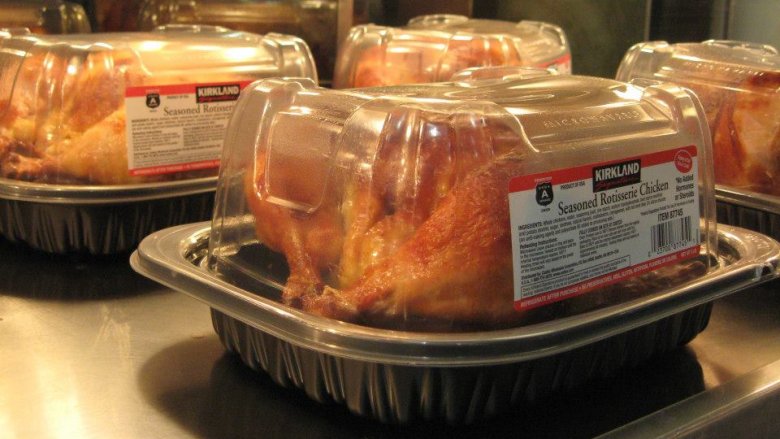This Is Why Costco Only Charges $5 For A Rotisserie Chicken
If you're the observant sort of shopper who wants to get the most out of every dime (and who doesn't?), it's possible you've noticed that Costco's 3-pound rotisserie chickens are actually cheaper than some of their other forms of chicken — including their uncooked ones. They're also among the cheapest rotisserie chickens around, and considering how much meat you're getting, it's a deal that seems too good to be true.
It doesn't even seem like it could be a good business decision to have these on offer every day — these super cheap chickens can't be a big money-maker, right? The chickens are popular enough that surely, they could raise the price and still sell them... yet still, that price point persists.
Anyone who suspects there's more going on here is right. Back in 2015, avian flu threatened the US poultry industry. Countless birds were lost, prices were uncertain, and Barclays analyst Meredith Adler asked Costco's chief financial officer Richard Galanti (via The Seattle Times) if this was going to be the thing that finally resulted in the price of their famous rotisserie chickens going up. Galanti didn't make any promises, but he did have this to say:
"I can only tell you what history has shown us: When others were raising their chicken prices from $4.99 to $5.99, we were willing to eat, if you will, $30 to $40 million a year in gross margin by keeping it at $4.99. That's what we do for a living."
That's an almost unthinkable amount of money. Is it possible that they're willing to sacrifice millions just for some good will with their customers?
Not so fast. That super cheap chicken isn't a benefit only to the customers. In fact, it's a sneaky way to get you spending more.
The Wall Street Journal took a closer look at the rotisserie chicken phenomenon, noting that it started with Boston Market in the 1990s, and it's one of the few '90s-era crazes that kept going strong into the next century. Costco started selling $4.99 chickens in 2009, sold 51 million of them in 2010, and 87 million in 2017. That's a lot of customers coming though Costco's doors, and each one of them is looking at all the other great bargains and cool stuff for sale, while on their way to get their chickens from the back of the store. That's right, there's a reason they keep the chickens all the way in the back — and it's working.
Costco isn't the only chain selling rotisserie chicken, and according to Don Fitzgerald, vice president of merchandising at the Kroger-owned Mariano's, it's all about getting people in the door for the chicken, and encouraging them to pick up other things to go with it.
"If they get a chicken, a salad, and maybe they pick up a bottle of wine — now we're really talking," he told WSJ. Given that you know you're getting such a good deal on the chicken, it's entirely likely you might splurge elsewhere, and opt for a few high-profit items — and that's where they're really making their money.
While Costco isn't the only player in the rotisserie chicken game, they're taking steps to go above and beyond their competition. Since they started selling, they've invested in larger, high-efficiency ovens, and containers made with less plastic. Those things both help keep their costs down, too.
And, in 2018, The Seattle Times reported Costco was investing around $300 million in a massive chicken farm located in eastern Nebraska. The centrally-located state was chosen, in part, because of the large corn and soybean production there, which will save Costco on feed costs. That's important, because they're going to have a lot of chickens to feed: an estimated 100 million a year.
That's about a quarter of the number of chickens Costco sells in a year (not counting just the rotisserie ones), and there are other plans in the works, too. They're in talks to raise hundreds more chicken barns, and while it's a hefty initial investment, it's going to help their keep costs low in the future.
Now, let's get back to something we mentioned before: Costco sells their rotisserie chickens at a lower price than uncooked chickens, and given how much more work goes into the cooked ones, that seems odd. Time Money says there might be another reason for this, too — cooked chickens are going to go bad faster, and they want to keep them at a price point that'll make sure they're continuously going out the door. They definitely do at that price!
It's also worth noting that rotisserie chickens aren't the only products Costco has said they'll keep at these insanely, super-low prices. Their jumbo hot dog and drink deal has been priced at $1.50 since, Time says, the mid-1980s. It's all about increasing foot traffic, and that's been particularly challenging for stores like Costco, that generally aren't located in super-convenient areas where people might pop in regularly to see what's on the shelves. They need a reason to make the trek to Costco, and what's a better reason than a quick (and cheap) bite — or a tasty, low-cost dinner that's ready to serve?
